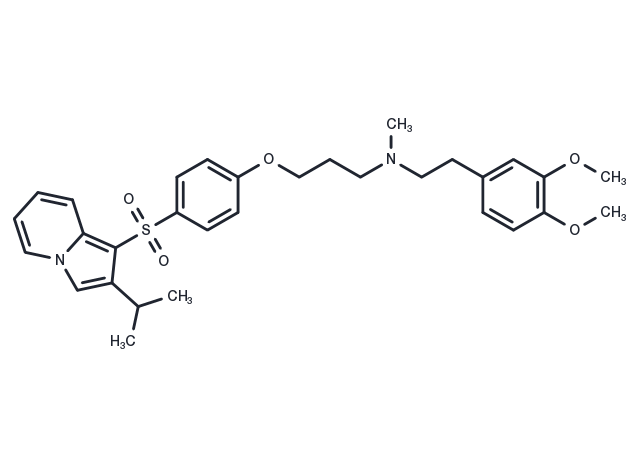Powder: -20°C for 3 years | In solvent: -80°C for 1 year


Fantofarone (SR 33557) is a highly potent antagonist of Calcium Channel.

| Pack Size | Availability | Price/USD | Quantity |
|---|---|---|---|
| 1 mg | In stock | $ 31.00 | |
| 5 mg | In stock | $ 72.00 | |
| 10 mg | In stock | $ 122.00 | |
| 25 mg | In stock | $ 247.00 | |
| 50 mg | In stock | $ 409.00 | |
| 100 mg | In stock | $ 531.00 | |
| 1 mL * 10 mM (in DMSO) | In stock | $ 88.00 |




| Description | Fantofarone (SR 33557) is a highly potent antagonist of Calcium Channel. |
| In vitro | Calcium channel blockers VIZ and Fantofarone (SR) exhibit modest antimalarial effects compared to chloroquine (CQ), with slightly greater efficacy against CQ-resistant parasites. Notably, Fantofarone is approximately 10 times more effective than verapamil. Isobologram analysis indicates these blockers enhance CQ sensitivity in CQ-resistant P. falciparum, with verapamil being 2 to 3 times more effective than Fantofarone in reducing CQ resistance at comparable subinhibitory concentrations. |
| In vivo | Administration of isosorbide dinitrate (0.3 mg/kg, i.v.) or Fantofarone (50 mg/kg, i.v.) results in a decrease in both the frequency and severity of vasospasm, with Fantofarone showing the greatest efficacy in mitigating vasospasm across both distal and proximal regions. In contrast, verapamil (0.2 mg/kg, i.v.) exhibits markedly less effectiveness. While isosorbide dinitrate effectively suppresses distal arterial intraluminal volume (AIV) reduction, it does not significantly impact the decrease in proximal diameter. Conversely, Fantofarone stands out for its substantial reduction of AIV across the experiment, whereas verapamil fails to significantly affect AIV. |
| Animal Research | Male White rabbits are used in this study (3.0-3.2 kg). All surgical procedures are performed under anaesthesia with a mixture of ketamine and xylazine. At the end of the experiments, the animals are sacrificed by a pentobarbital overdose. The proximal femoral arteries are exposed, and the isolated arterial segments are desiccated by air infusion delivered at a rate of 80 mL/min for 8 min. After desiccation is completed, the ligatures are released and flow is restored. At the day of surgery, a 2% cholesterol/6% peanut oil diet is started for 2 weeks. Before angioplasty, the animals are randomized in 4 groups of 10 animals:1. Placebo, 1 mL/kg of NaCl 0.9%, 2. Isosorbide dinitrate, 0.3 mg/kg, 3. Verapamil, 0.2 mg/kg, 4. Fantofarone, 50 mg/kg. The doses of isosorbide dinitrate, verapamil, and fantofarone are defined in a pilot experiment as the highest doses which did not show any hypotensive effect per se and are chosen very carefully according to their activity measured in other pharmacological models. |
| Synonyms | SR 33557 |
| Molecular Weight | 550.71 |
| Formula | C31H38N2O5S |
| CAS No. | 114432-13-2 |
Powder: -20°C for 3 years | In solvent: -80°C for 1 year
DMSO: 150 mg/mL (272.38 mM), Sonication is recommended.
You can also refer to dose conversion for different animals. More
bottom
Please see Inhibitor Handling Instructions for more frequently ask questions. Topics include: how to prepare stock solutions, how to store products, and cautions on cell-based assays & animal experiments, etc.
Fantofarone 114432-13-2 Membrane transporter/Ion channel Metabolism Microbiology/Virology Parasite Calcium Channel SR 33557 Ca channels SR33557 inhibit SR-33557 Inhibitor Ca2+ channels inhibitor
